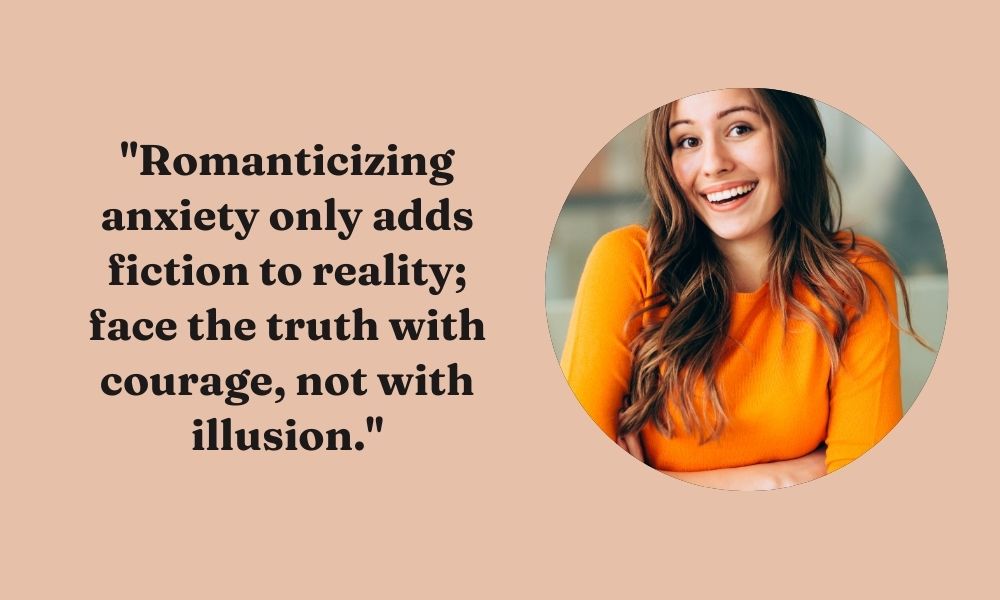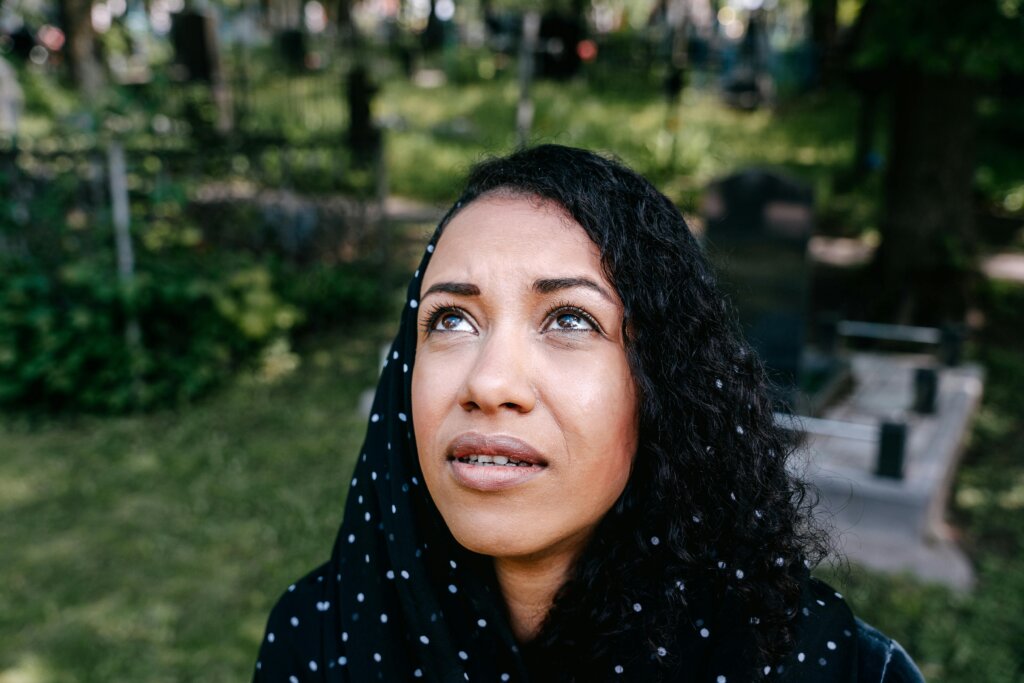Today we will talk about a unique and deep topic – “Romanticize Anxiety”. Understanding this issue of anxiety, and why we people want to see so much romanticism, is quite important. So, let’s start with a small overview.
It is very important to understand the meaning of anxiety. This is a mental state in which humans feel constant worry, fear, or discomfort. Everyone faces anxiety at some point in their life, but it is important to understand its true form.
Now we come to the fascinating phenomenon – “Why We Romanticize Anxiety”. This thing is so mysterious in itself.
Why do people think romanticizing anxiety is some kind of glamor? Before talking more deeply about this, let’s understand why this happens.
Historical Context Of Romanticize Anxiety

First, let’s talk about “anxiety in literature.” You may have noticed, but in many stories, old and new, anxiety is a common theme. Poets, writers, and artists have depicted anxiety as a powerful emotion in their work.
This gives us an understanding of how long anxiety has existed in our society.
Now let us come to “Romanticism Movement and Anxiety”. This is a very interesting connection. During Romanticism, which was in Europe in the 18th and 19th centuries, people’s attitudes changed.
He celebrated nature, emotion, and individuality. But despite this movement, anxiety was also a big part. People’s emotions, their fears, and their existential crisis added a new color to the style of Romanticism.
From this we understand that there is a deep connection between anxiety and romanticism. Let us now talk about the “psychological perspective” of “historical context”.
Anxiety has great importance in psychology. There are various philosophies on this topic, which help us understand this emotion.
The first philosophy is the “psychoanalytic perspective“. Great psychologists like Freud understood that anxiety is related to our unknown desires and unresolved conflicts.
According to this, when there is something hidden in our mind which is not known to our cognitive power, then we feel anxiety.
The second thing is “mental attitude“. According to this, anxiety is linked to our distorted thoughts and beliefs. When we have negative or excessive thoughts in our mind, we feel anxiety.
And then comes the “biological approach”. According to this, some part of anxiety is related to our genetics and brain chemistry. Imbalance of hormones and neurotransmitters can also be a cause of anxiety.
All these approaches give us an understanding of different aspects of anxiety and how it can be addressed. ( Romanticize anxiety )
The Allure of Anxiety
First of all, let’s talk about “Perceived Depth and Complexity“. Many times people feel that anxiety makes their personality deep and complex.
They feel that there is a different depth to their feelings and thinking, which makes them more interesting.
Then comes “Society’s Influence“. In today’s world, we often feel the pressure of society’s expectations and rules. Anxiety, in a way, is a reflection of society’s pressure.
People think that if they have anxiety, they are not normal, but it is important for them to understand what its basic nature is.
And then comes “Romanticizing Mental Health”. Many people view mental health from a romantic and artistic perspective. They feel that mental health problems make them more sensitive, creative, and deeper.
But this can be dangerous, because it does not solve the real problems, but deepens them.
All these things give us an understanding of why people are so fascinated by anxiety, and it is important for us to understand how to deal with it.
Media and Popular Culture

Portrayal in Films and TV Shows
Let us now see how anxiety is seen in “Media and Popular Culture”, and how it affects our society.
First of all, let’s talk about “Portrayal in Films and TV Shows”. You might have noticed that in many films and TV shows, characters are shown facing anxiety. Sometimes these characters relate to our lives and make us feel in their shoes.
In films such as “Silver Linings Playbook” and TV shows such as “BoJack Horseman”, anxiety has been portrayed in a realistic manner. It shows how anxiety impacts our relationships, career, and overall well-being.
But sometimes, anxiety is also sensationalized in films and TV shows. This can give people the wrong impression that anxiety is just dramatic or exaggerated, whereas in real life it very well affects our day-to-day affairs.
This gives us an understanding of the role media and popular culture play in anxiety, and how it impacts our society’s attitudes and thinking. ( Romanticize anxiety )
Social Media Trends
Social media has added a new dimension to our lives, and it also impacts anxiety. Nowadays, we often see posts, memes, and quotes related to anxiety on social media platforms.
Some people share their anxiety in an open and honest manner, which helps in increasing awareness. But sometimes, anxiety is also glamorized on social media.
People try to get attention or sympathy by sharing their struggles, which actually weakens mental health awareness.
Additionally, “fear of missing out” (FOMO) also plays a big role on social media, which can also be a cause of anxiety.
People’s comparison of their life’s moments and achievements, which are highlighted on social media, can become a major cause of anxiety.
Overall, social media trends have given a new platform to anxiety, but we should understand what is its proper use and what is not.
And it’s also important to remember that social media is just a small part of life, and it’s only through genuine connection and self-care that we can find real satisfaction.
Impact on Perception
Media and popular culture have a huge impact on our attitudes and perspectives. When we repeatedly see anxiety in movies, TV shows, or on social media, it also affects our thoughts and ideas.
Sometimes, media portrayals leave people with the impression that anxiety is just a romantic or glamorous feeling. This causes people to ignore real problems and take their mental health problems lightly.
On the other hand, certain media content and popular culture representations increase our awareness and try to make us understand what anxiety is and how to deal with it.
But it is also important that we focus on correct and accurate information, so that people can understand and understand their mental health in the right way.
Overall, media and popular culture have a huge impact on our perspective, and hence we must consume media content consciously and wisely, so that we can move in the right direction and improve our mental health. ( Romanticize anxiety )
Romanticizing Symptoms
Endorsing Struggle as Virtue
Many times we see that people romanticize their anxiety symptoms, and consider them to be a kind of virtuous quality of struggle or suffering.
An example of this is when people perceive their extreme stress, anxiety, or panic as a kind of table of support or evidence of the authenticity of their dedication.
Such people think that if they have anxiety, it is a proof of their hard work and dedication. But this is a misconception.
The romanticization of anxiety and endorsing struggle as virtuous actually harms our mental health and well-being.
This kind of thinking promotes us to endorse unhealthy coping mechanisms and gives us a tendency to hide or ignore our problems instead of finding true solutions.
Therefore, it is important for us to understand that romanticizing the struggle or pain is not right in any way and we should handle our mental health issues in the right way. ( Romanticize anxiety )
Understanding and Coping with Depression After Tooth Extraction
Glamorization of Suffering
Sometimes people make their anxiety symptoms appear glamorous or attractive. They feel that their suffering makes them different and unique.
This way of thinking helps them get attention, sympathy, or recognition. But this is a misconception. Glamorizing suffering can actually lead us to further isolation and suffering. There is nothing glamorous about it, just pain and struggle.
This glamorous portrayal of suffering can prevent us from truly understanding it. We must remember that by glamorizing or glamorizing mental health issues, we are not providing real solutions to them.
Rather we should move towards understanding them and getting the right treatment and support.
Misconceptions and Realities
Many times people have misconceptions in understanding the symptoms of anxiety. They think that anxiety is just a temporary state or just a phase that will pass.
But in reality, anxiety can be a chronic condition that becomes a regular part of any person’s life.
Apart from this, some people think that anxiety is just a small thing or just a figment of imagination. But this is a misconception.
Anxiety is a real and serious mental health issue that affects a person’s thoughts, feelings, and behavior.
We must also remember that anxiety can be associated with any age, gender, or background. It is not a symbol of anyone’s weakness.
There is no need to feel any shame or guilt in this. We should understand our mental health and move towards right treatment and support, without any misconception. ( Romanticize anxiety )
Coping Mechanisms

Romanticizing as Coping Strategy
Sometimes people romanticize their anxiety to cope. He feels that if he looks at his feelings from an artistic or poetic perspective, his burden will become lighter.
But this is a temporary solution. Romanticizing your anxiety does not help in long-term healing and recovery. Due to this, we only create a tendency to ignore our problems, whereas it is necessary for us to face them.
Finding Comfort in Vulnerability
The second coping mechanism is to find comfort in your vulnerability. Many times people feel a sense of comfort and connection by expressing their anxiety, or sharing their struggles with others.
There is nothing wrong with this. Showing vulnerability and sharing your feelings is an important step toward understanding and improving your mental health.
But it is also important that we learn the right way with whom and how to share our struggles, so that we can get the right support and guidance.
Healthy vs. Unhealthy Coping
Coping mechanisms are a way to handle our mental health. But it is important that we use the right coping mechanisms, because some coping strategies are healthy while some are unhealthy.
Healthy coping mechanisms include stress-reducing activities like exercise, meditation, and deep breathing exercises.
Additionally, expressing your feelings, talking to supportive friends or family, and seeking professional help are also part of healthy coping.
But unhealthy coping mechanisms include alcohol or drug use, emotional eating, and social withdrawal. Temporarily avoiding or suppressing your problems in these ways can harm our mental health in the long term.
Therefore, we should always remember to use healthy coping mechanisms to cope with our anxiety or other mental health issues.
We should understand our emotions and handle them properly, so that we can improve our mental health. ( Romanticize anxiety )
Romanticizing Anxiety Disorders

Differentiating Anxiety from Anxiety Disorders
First of all we need to understand what is the difference between anxiety and anxiety disorders. Anxiety is a normal emotion that happens to everyone at some point in their lives.
But anxiety disorders are a mental health condition that adversely affects a person’s everyday life.
Anxiety disorders include generalized anxiety disorder (GAD), panic disorder, social anxiety disorder, and specific phobias.
It is important to get timely diagnosis and treatment of any of these disorders, because it can have a negative impact on a person’s life.
The Dangers of Glamorization
There is a huge danger in glamourising anxiety disorders. When we start looking at them from a romantic or glamorous angle, we ignore their seriousness and severity.
Due to this, people take their mental health issues lightly and do not seek proper treatment and support.
Destigmatizing Mental Health
It is important to destigmatize mental health so that people do not have any hesitation in discussing their mental health issues in an open and honest manner.
We should raise awareness that mental health issues are a normal part of life, and there is no need for any person to feel shame or stigma.
Therefore, we should work towards destigmatizing mental health in our society and raising the right awareness, so that everyone can get the right support and treatment. ( Romanticize anxiety )
Art and Expression

Creative Outlets for Anxiety
An important aspect of coping with anxiety is to use creative solutions. When we express our feelings, we find a unique form of relief and healing.
Creative solutions help us release our emotions and deal with our internal conflicts.
Poetry, Music, and Art
Some people express their anxiety by writing poetry, making music, or creating art. All these mediums provide us with a safe space to express our feelings, where we can express our feelings through words, tones, or colors.
In poetry we can convert our innermost thoughts and feelings into words. Music gives us a chance to express our feelings through rhythm and melody. And art, like painting or sketching, brings our emotions into visual form.
Healing through Expression
All of these forms of expression provide us with a powerful means of healing. When we indulge our creative enthusiasm, our attention shifts from our anxiety to something else.
These provide us with relaxation and mental clarity, which helps us cope with our anxiety.
So, if you suffer from anxiety or any other mental health problem, find your creative outlet and find a healthy way to express your feelings.
This will not only give you relief but will also improve your overall mental health. ( Romanticize anxiety )
Intersectionality
Gender and Anxiety Romanticism
When we talk about romanticization of anxiety, we should also take into account the traumatization, especially in the context of gender.
The way anxiety is interpreted varies by gender and is an important aspect in understanding mental health.
Many times, there is a stereotype in society that women are more sensitive and emotional, and hence this stereotype is reinforced even when they have anxiety.
Women like to romanticize their anxieties and look at them from an artistic and poetic perspective, which makes them seem delusional or fragile.
Whereas in the case of men, they may find it more difficult to show or express their concerns because they are viewed through a stereotype in society that makes them strong and emotionless.
For this reason, it may be difficult to romanticize or even express their anxiety.
Thus, understanding and addressing the romanticization of anxiety is also different in the context of gender.
Therefore, we must look at mental problems by including gender roles and expectations in our understanding, so that we can provide the right solutions and support.
Cultural Influences
When we talk about romanticization of anxiety, we must also take into account the cultural influences.
The way anxiety is interpreted is different in every culture, and this also affects the way we understand and cooperate collectively.
In some cultures, it is considered taboo to express or seek solutions to concerns. People hide their feelings and feel humiliated or ashamed when they express them.
Because of this, it becomes more difficult for them to romanticize their worry or find solutions to it.
At the same time, in some cultures, it is considered important to openly discuss and find solutions to anxiety and other mental health problems.
For this reason, people can express their feelings freely and have an easier time finding support and treatment. ( Romanticize anxiety )
Socioeconomic Factors
And then come socio-economic factors. Our economic status, access to health services, and resources also affect our mental health.
If someone does not have financial resources, their access to mental health services and treatment is limited. For this reason, their way of dealing with anxiety may also be different.
Along with socio-economic factors, education and job security also have a big impact on our mental health. If someone is worried about their job or financial stability, their anxiety level may also increase.
Thus, cultural influences and socio-economic factors play an important role in understanding and addressing our mental health.
Therefore, we should look at mental health problems in our society by including these factors, so that we can provide the right solutions and support.
Breaking the Cycle
Recognizing Harmful Patterns
The first step toward breaking the cycle is to recognize harmful patterns. Many times there are patterns in our lives that harm our mental health. These patterns can cause us anxiety and stress.
These may include negative self-talk, avoidance behavior, and unhealthy coping mechanisms such as substance blame or social isolation. It is important to recognize these patterns so that we can change them and improve our mental health. ( Romanticize anxiety )
Promoting Authenticity
The second step is to encourage truthfulness. Understanding our true nature and acting on it helps us improve our mental health.
When we recognize and accept our true feelings, we feel happy and satisfied. Therefore, we must embrace our true nature and encourage others to do the same.
Embracing Imperfection
The third step is to embrace incompleteness. No human being’s life is perfect and everyone deals with their own shortcomings and faults. Our imperfections make us special and give us empathy for each other.
Therefore, we should accept our incompleteness and encourage others to appreciate their incompleteness as well.
By following these three steps we can improve our mental health and strengthen health and live a positive and satisfied life.
The Role of Therapy
Therapy as an Antidote
Therapy is an important solution when we are facing our mental health issues. Therapy provides a safe and supportive space for us to understand and resolve our feelings.
Therapists provide us with tools and techniques to better address our anxiety and other mental health problems.
Therapy gives us a new perspective and insight from which we can properly see and solve the challenges of our life.
Destigmatizing Seeking Help
Seeking therapy or counseling is a big step toward improving your mental health, but many times people approach it with stigma. Because of this, many people avoid therapy or counseling and hide their problems.
But we must remember that taking therapy is not a weakness, but a sign of strength. It is important to prioritize our mental health and if someone needs therapy, we should be open to learning and accepting it.
Self-Compassion and Healing
The last step is self-compassion and healing. Loving ourselves and treating ourselves with self-kindness is essential to restoring mental health.
We must learn to understand ourselves and accept our incompleteness. Self-compassion gives us the ability to be gentle and understanding with ourselves, which helps improve our mental health.
So, if you feel you need therapy, there is no need to be afraid. Seeking therapy is a big step towards improving your mental health and we should keep ourselves open to it. ( Romanticize anxiety )
Impact on Relationships

Romantic Relationships
A big part of anxiety is in love relationships. A person with anxiety faces more insecurities, doubts and fears, which impacts their relationships.
Many times, people with anxiety find it difficult to have open communication with their partner and are reluctant to share their fears. Because of this, there may be trust doubts and misunderstandings in their relationship.
But it is also true that with a supportive and understanding partner, a person with anxiety can properly understand their struggles and cope with them.
Open communication, empathy, and compassion are the foundation of a healthy love relationship, where the challenges of anxiety are also understood and supported.
Friendships and Family Dynamics
Anxiety also impacts friendships and family activities. Because a person with anxiety has fearful and uncomfortable feelings about social interactions, they find it difficult to connect with their friends and family.
Because of this, their friendships and family relationships may become distant.
But with supportive friends and family members, people with anxiety can strengthen their support system and feel comfortable sharing their feelings.
With empathy and understanding, their friends and family can provide them with the right support and guidance.
Communicating Needs Effectively
The most important thing is to communicate your needs effectively. In times of anxiety, it is very important to be clear about our needs and feelings and communicate them to the other person.
Making our partner, friends, and family aware of our needs and boundaries strengthens our relationships and reduces misunderstandings.
So, if you’re struggling with anxiety, express your feelings clearly and don’t hesitate to communicate your needs.
And if you’re with someone who is struggling with anxiety, try to understand their feelings and provide them with the right support and empathy. ( Romanticize anxiety )
Addressing Toxic Positivity
The Pitfalls of “Just Be Positive”
Many times we hear that “just be positive” or “everything will be fine”. But this is an example of paradoxical positivity.
When we stress about being positive, we ignore and suppress our negative emotions. Because of this, we don’t face our true feelings, which can be harmful to mental health in the long run.
Balancing Optimism and Realism
It is necessary to maintain a balance of optimism and reality. Instead of being positive, we should accept and address our emotions. This is not to say that we should completely ignore negative emotions.
Along with optimism, we must look at our current situation and challenges realistically. In this way, we can face our problems in the right way and also maintain our mental health.
Validating Negative Emotions
The last step is to acknowledge the negative emotions. Our negative emotions are also an important part of our emotions and it is wrong to ignore or suppress them.
We need to accept and validate our negative emotions. With this we can strengthen our mental health and increase our emotional organization.
Therefore, we should avoid negative positivity and try to cope with our emotions in the right way.
It’s important to stay positive, but if we accept our negative emotions too, we can improve our mental health. ( Romanticize anxiety )
Educating the Masses

Mental Health Education
A very important step in the field of mental health is to educate our society. Mental health education gives us correct information and awareness about mental health problems.
This education helps people understand and recognize what symptoms or behaviors may be indicative of mental health problems.
With mental health education, people can also be made aware against stigma and stereotypes. When people start understanding mental health problems and discussing them openly, stigma and discrimination reduce.
Because of this, it is important to have mental health education so that we can create a supportive and understanding society where everyone can get the right support and treatment.
Therefore, we should encourage mental health education in schools, colleges, workplaces, and communities.
And we must also contribute our efforts to raise awareness and provide people with the right information, so that everyone can prioritize their mental health and get access to the right support and treatment.
Media Literacy
In today’s digital age, media awareness has become an important aspect of mental health education.
Media, including social media, movies, TV shows, and online content, shapes our thoughts and beliefs, and also impacts representations related to mental health.
Media awareness means increasing our awareness and understanding of the media messages we receive daily. We need to understand how the media represents mental health problems and whether what it represents is realistic or stereotypical.
With this kind of awareness, we can recognize and question the negative messages that affect our mental health.
Furthermore, media awareness empowers us to consciously control our media consumption. We can curate our social media feeds, and avoid platforms that have a negative impact on our mental health.
We can critically analyze the content and message of our favorite TV shows and movies before watching them.
Overall, media awareness is a powerful tool in mental health education, empowering us to control our media consumption and recognize accurate information and representation.
Therefore, we must improve our media awareness so that we can better understand our mental health and access the right support and resources. ( Romanticize anxiety )
Promoting Authentic Narratives
Another important aspect of mental health education is to encourage real stories.
When we share real stories and experiences, we provide people with real-life examples that inspire them and help them understand their mental health.
Real stories mean sharing real-life experiences, struggles and triumphs. When we share our personal experiences in an open and honest way, we connect with people and send them the message that they are not alone with their struggles.
Additionally, real stories can also challenge stigmas and stereotypes. When we share our real-life stories, we show people that mental health problems can affect anyone, and that anyone should have access to the right support and treatment.
Therefore, we need to share our personal experiences and encourage real narratives, so that we can increase people’s awareness and understanding and help them access the right support and resources.
Bipolar Ups & Downs: Living with Bipolar Disorder – My Personal Journey
Overcoming Romanticization
Building Resilience
An important way to deal with romanticization is to create Sanjivani. Sanjivani means staying strong with your challenges and struggles, and learning and growing from them.
When we don’t romanticize our mental health problems, we discover our inner strength and become our survivors.
To make a living, we have to develop the ability to face our problems and deal with them. To do this, we need to accept our feelings, set our boundaries, and lean on our support systems.
When we strengthen our vitality, we are better able to cope with our mental health problems. ( Romanticize anxiety )
Embracing Authenticity
Another way to deal with romanticization is to embrace reality. When we accept our true self and express our feelings openly, we are better able to deal with our mental health problems.
Basically, we acknowledge our struggles and find the right way to deal with them.
Finding Meaning in Recovery
After all, finding meaning in svanasana is also an important part of dealing with romanticization. Svanasana means the process of healing from our mental health problems, and in this process we need to find meaning and purpose in our journey.
When we find meaning in our svanasana, we see our struggles in a positive context and learn from them.
Therefore, to combat romanticization, we need to make sanjivani, embrace reality, and find meaning in svanasana.
When we follow these steps, we can live a healthy and balanced life by giving proper priority to our mental health.
Exploring Facts & Stats
Facts & Stats on Romanticizing Anxiety:
- Social Media Impact: A 2021 study published in the Journal of Youth and Adolescence found that exposure to social media content romanticizing anxiety symptoms (e.g., “anxiety is my superpower”) was linked with increased anxiety levels in young adults [Source: Journal of Youth and Adolescence, “Social Media Exposure and Anxiety Symptoms in Emerging Adults: The Mediating Role of Rumination and Social Comparison”].
- Mental Health Stigma: The National Alliance on Mental Illness (NAMI) reports that 1 in 5 adults in the US experiences mental illness in a given year, but only 43.5% receive treatment [Source: National Alliance on Mental Illness, “Mental Health By the Numbers”]. This stigma can be perpetuated by romanticizing anxiety, making people less likely to seek help.
- Misconceptions about Anxiety Disorders: The Anxiety and Depression Association of America (ADAA) reports that anxiety disorders are the most common mental illness in the US, affecting 40 million adults (18 and older) in the past year [Source: Anxiety Disorders Association of America, “Anxiety Disorders”]. Romanticizing anxiety downplays the severity of these disorders.
Resources on Romanticizing Anxiety:
- The Jed Foundation: https://jedfoundation.org/ – This organization provides mental health resources for teens and young adults, including information on anxiety and how to seek help.
- The Mighty: https://themighty.com/ – An online community for people with chronic illness and mental health conditions. The Mighty publishes articles and stories about anxiety and mental health challenges.
- The Trevor Project: https://www.thetrevorproject.org/ – A crisis intervention and suicide prevention organization for LGBTQ youth. Anxiety is a common issue among LGBTQ youth, and The Trevor Project provides resources and support.
Conclusion
We talked about the topic of “Romanticize Anxiety” and its effects. We looked at how romanticizing anxiety can be a tempting, but harmful trap.
In this process, we overlook our mental health problems and start seeing them in a brighter light. But this approach harms our mental health and keeps us away from the right support and treatment.
At this time, we need to increase mental health awareness in our society. We must promote open conversations about mental health among our friends, family and communities.
We must also consciously control our media consumption and promote genuine narratives. And most importantly, we must prioritize our mental health and if someone needs help, we must help them access the right support and treatment.
Ultimately, I would like to say that real life is the key to a healthy and fulfilling life. When we accept our true self and express our feelings openly, we strengthen our mental health.
Every person is unique and everyone has their own struggles. Therefore, we must embrace reality in our journey and live a meaningful and happy life by making our mental health a priority.
Let’s all come together to create a supportive and understanding community where everyone can understand their mental health and have access to the right support.
This is a journey we must all take together, because we are all important to each other. Thank you.
I hope you have liked the information we have shared in our article, to know more about this you can read our other article too.
Frequently Asked Questions (FAQs)
Q: What does it mean to “romanticize anxiety”?
A: Romanticizing anxiety refers to portraying it in a glamorous or desirable light, often overlooking its detrimental effects on mental health.
Q: Why do people romanticize anxiety?
A: People may romanticize anxiety due to societal pressures or misconceptions, viewing it as a sign of sensitivity or depth.
Q: What are some common misconceptions about anxiety romanticism?
A: One common misconception is that anxiety adds depth or allure to one’s personality, when in reality, it can be debilitating and harmful.
Q: How does romanticizing anxiety affect mental health awareness?
A: Romanticizing anxiety can obscure the seriousness of mental health issues, making it harder for individuals to seek proper support and treatment.
Q: Are there any positive aspects to anxiety romanticism?
A: While some may perceive a certain allure in romanticizing anxiety, it ultimately perpetuates harmful stereotypes and prevents individuals from seeking help.
Q: How can we combat the romanticization of anxiety?
A: Combatting anxiety romanticism involves raising awareness about the true nature of mental health issues and promoting empathy and understanding towards those affected.
Q: What role does the media play in romanticizing anxiety?
A: Media often portrays anxiety in a romanticized manner, glamorizing struggles and reinforcing stereotypes, which can influence how individuals perceive and internalize their own anxiety.
Q: How can individuals distinguish between romanticized portrayals of anxiety and reality?
A: By educating themselves about mental health, challenging societal norms, and seeking support from reliable sources, individuals can learn to differentiate between romanticized depictions of anxiety and the actual lived experience.
Q: What resources are available for those struggling with anxiety?
A: There are various resources available, including therapy, support groups, hotlines, and online forums, where individuals can seek guidance, understanding, and professional help for managing anxiety.